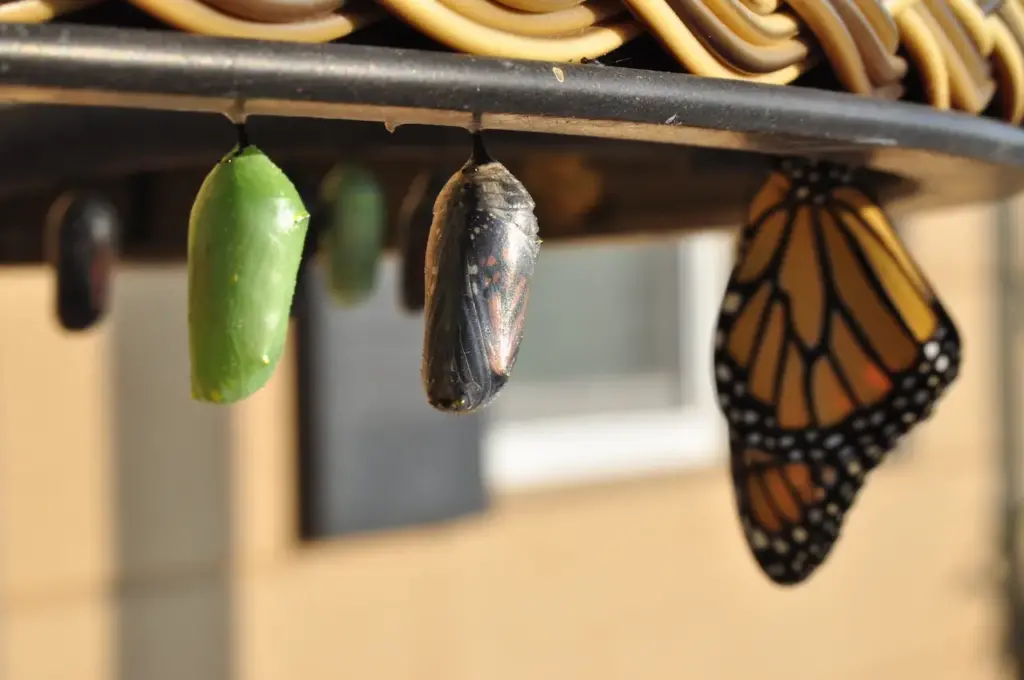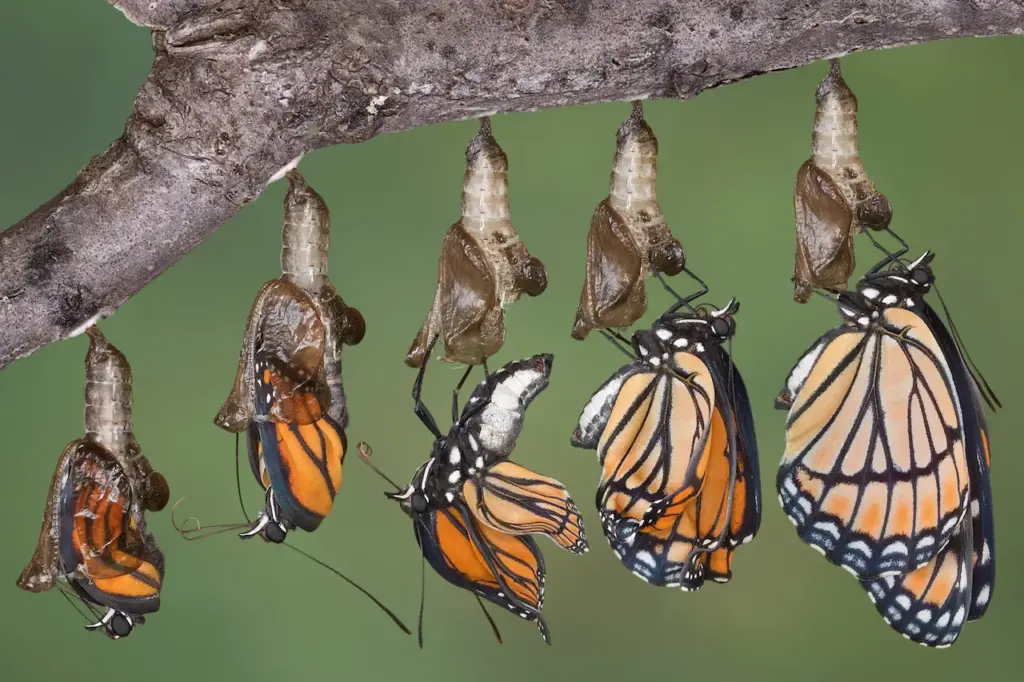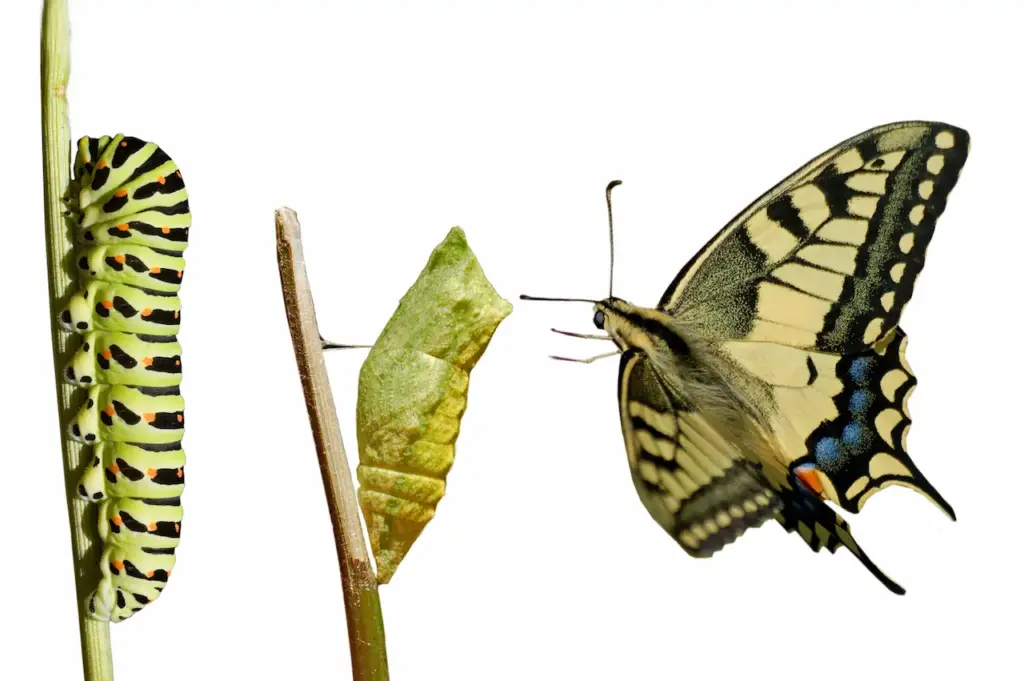Metamorphosis is a fascinating biological phenomenon that involves a considerable change in an animal’s body structure and physiology as it matures from juvenile to adulthood. This sophisticated process has three main stages: egg, larva, and adult.

Juvenile organisms go through significant transformations that shape them into their mature forms during metamorphosis. This occurrence highlights the intricacy of life’s developing journey while showcasing the wonders of nature’s meticulous design.
The Three Stages of Metamorphosis
Metamorphosis occurs in three stages:
Egg Stage
An egg is the starting point of the transformation process. An embryo is created when a sperm cell fertilises an egg, and the zygote starts to divide rapidly. The yolk serves as sustenance for the developing embryo inside the eggshell. The creature keeps developing at this point until it emerges from the egg.
The eggs of butterflies, moths, beetles, flies, bees, wasps, ants, amphibians like frogs, and marine creatures like crabs or lobsters are a few examples of creatures that go through metamorphosis.
Depending on the species, the eggs may be placed on leaves, in water, or underground, among other safe spots. Before the larvae hatch, the egg stage might endure for a few days to several months.
Larva Stage
The next stage of metamorphosis is the larva stage. Larvae hatch out of eggs and look significantly different from the adult form. Common larval forms include caterpillars, grubs, maggots, tadpoles, and nymphs.
Larvae need to feed a lot to support their rapid growth. Their primary activity at this stage is eating. Larvae moult or shed their external skeleton several times as they outgrow their skin.
Molting allows the larvae to grow larger after each successive shedding of the skin. The larva stage lasts for several weeks or months, depending on the species. It ends when the larvae enter the pupa or chrysalis phase.
Examples of common larval forms:
- Caterpillars – larvae of butterflies and moths
- Grubs – larvae of beetles
- Maggots – larvae of flies
- Tadpoles – larvae of frogs and toads
- Nymphs – larval forms of insects like grasshoppers, dragonflies, and cockroaches.
Pupa or Chrysalis Stage
In the pupa or chrysalis stage, the larva forms a protective cocoon or shell around itself called a pupa or chrysalis. Inside this cocoon, the larva begins the transformation into an adult through a process called complete metamorphosis.
It develops adult body parts like wings, legs, compound eyes, and external genitalia. The pupa does not feed or move around. It remains encased in the cocoon until the transformation into the adult form is complete. This resting period can range from a few weeks to several months, depending on the organism.
Examples of the pupa stage:
- Pupa of butterflies and moths
- Cocoons spun by caterpillars
- Chrysalis of butterflies
- Pupa of flies
- Nymphs undergo a final moult before becoming adults like dragonflies, mayflies etc.
When metamorphosis is complete, the adult organism emerges from the pupa, ready to take on the world!
Types of Metamorphosis
Complete vs. Incomplete Metamorphosis
There are two main types of metamorphosis:
Complete Metamorphosis
Complete metamorphosis has four very distinct developmental life stages – egg, larva, pupa, and adult. As mentioned earlier, butterflies, moths, beetles, flies, bees, ants, wasps, amphibians, and some marine creatures undergo complete metamorphosis.
Complete metamorphosis allows larvae to adapt to lifestyles very different from those of adults. The larva has distinct environmental stresses, needs, and demands for survival since it resides in a different ecological niche than the adult.
The animal can feed, grow, and develop in an environment that is optimal for that stage alone when it has a specific larval stage. Thus, there are notable differences between the larval and adult bodies. This is called holometabolism.
For example, caterpillars can maximise growth by consuming large quantities of leaf matter. Meanwhile, the adult butterfly can focus on flying, reproducing, and sippling nectar without having to lug a fat body designed for eating leaves!
Incomplete Metamorphosis
In incomplete metamorphosis, the egg hatches into a nymph or immature form that resembles a smaller version of the adult. The nymph gradually grows by moulting its outer skin and reaches adulthood without going through a pupa stage.
Insects like grasshoppers, true bugs, dragonflies, cockroaches, cicadas, and aphids undergo incomplete or partial metamorphosis.
There are three stages – egg, nymph, and adult. Since the nymph resembles the adult cricket or grasshopper, it inhabits the same environment and eats the same food. The change between juvenile and adult is not as dramatic as complete metamorphosis.

Why Do Animals Undergo Metamorphosis?
The drastic transformation observed during metamorphosis may seem counterintuitive at first. Why don’t organisms grow continuously from babies to adults?
Metamorphosis offers important survival and reproductive advantages. Here are some of the main evolutionary benefits of metamorphosis:
Escape Predators
Larvae and eggs make it easy to pick for predators. Caterpillars are slow-moving and have soft bodies without defense mechanisms. Hiding out in a tough chrysalis or cocoon prevents predators like birds from snacking on the vulnerable pupating young.
Tadpoles swimming in ponds are easy for fish to swallow whole. Metamorphosing into a toad with poison glands on land allows the adult frog to escape aquatic predators.
Reduce Competition Between Young and Old
Larvae and adults occupy different habitats, so they are not competing for the same resources. Caterpillars can focus on munching leaves while adult butterflies fly off to sip nectar.
Tadpoles swim and feed underwater before metamorphosing into terrestrial, air-breathing frogs. Reduced competition between different life stages is beneficial for the species’ survival.
Use Resources Efficiently
Larvae and adults often adapt to use resources in their environment in an efficient manner. Since caterpillars spend weeks voraciously eating leaves, their stout bodies and strong mandibles are perfectly designed for the task. However, this bulky body would make flight difficult.
The streamlined, lightweight adult butterfly body utilizes nectar resources more efficiently. The long-coiled proboscis on the head is ideal for sucking up liquid nectar. Different body structures allow larvae and adults to use environmental resources in an optimal way.
Disperse Geographically
Larvae and adults sometimes inhabit different geographical areas. Caterpillars may cluster together on plants, while the adult butterflies disperse over a wider territory. This allows the species to spread out and colonise new habitats. Dispersal promotes genetic diversity and expands the range of the species.
Seasonal Timing
Some organisms time their metamorphosis to take advantage of seasonal conditions. Larvae grow rapidly under ideal summer conditions.
Before harsh winter conditions set in, they become dormant pupae. As adults, they emerge during the favourable conditions of spring.
Unique Examples of Metamorphosis
While all metamorphosis features remarkable transformations, some are particularly bizarre and fascinating:
Parasitoid Wasps
Parasitoid wasps exhibit a unique life cycle where their larvae develop inside the bodies of other insects, such as caterpillars or beetle larvae.
These developing larvae tunnel through the host’s tissues, releasing chemicals that paralyse and suppress the host’s immune response.
Some species even kill and liquefy the host’s internal organs to create a nutrient broth, while others allow the host to continue living as they consume non-essential tissues.
Once the larvae finish their feeding and growing process, they emerge as fully formed adults, marking a dramatic metamorphic change from living inside another organism to becoming free-living adults.
Flatworms
Flatworms, specifically the larval stage known as planula, have cilia for swimming and capturing planktonic prey. As they mature into adults, they undergo significant structural remodelling, losing their cilia and attaching headfirst onto coral reefs using a flattened underside foot.
Their tentacles, now adapted for filter feeding, extract food from passing water currents. Some species form large, colourful colonies, showcasing their adaptation to new food sources and sedentary lifestyles.
Barnacles
Barnacles undergo a remarkable transformation from larvae, called nauplii, which have a single eye and use swimming appendages to catch phytoplankton. Later-stage cyprid larvae use temporary glue glands to evaluate sites for permanent attachment.
Once cemented in place, they undergo metamorphosis into adult barnacles, surrounded by calcareous shell plates. Feather-like cirri appendages emerge, enabling filter feeding and illustrating extreme changes in mobility during their metamorphic process.
Axolotls
Axolotls, a unique species of salamanders, possess the rare ability to either undergo typical amphibian metamorphosis from aquatic larvae to land animals or remain in the larval form throughout adulthood, achieving sexual maturity while remaining aquatic.
Neotenous individuals retain larval features like gills, fins, flattened heads, and tails, remaining aquatic and paedomorphic. In contrast, metamorphosed adults adapt to terrestrial living, developing features like lungs, eyelids, and thick, moist skin while losing fins and gills.
Sea Squirts
Larval sea squirts called tadpoles have a primitive spinal cord and can swim freely. But adults become completely sedentary filter feeders. During metamorphosis, they essentially digest their own redundant brain and nervous system!
Froghoppers
The froghopper undergoes incomplete metamorphosis. However, developing from nymph to adult takes a bizarre route. The nymph excretes a frothy protective cover called cuckoo spit and actually pupates inside this bubbly spit!
Mealworm Beetles
The larvae of these beetles are called mealworms. The pupa forms a hard protective cocoon around itself made of shed larval skins held together with excreted silk protein. The adult beetle emerges from a tiny hole in the cocoon.
How are Hormones Involved in Metamorphosis?
The radical transformations of metamorphosis are orchestrated by hormones circulating in the bloodstream. Hormones act as chemical signals that trigger changes in gene expression and cellular activity. Two key players are juvenile hormone and ecdysone hormone:
Juvenile Hormone
This hormone is present at high levels in larvae and keeps them in the juvenile state. It suppresses the development of adult features. As JH declines towards the end of the larval stage, larvae become programmed to transition into the pupa.
Ecdysone
Ecdysone is secreted by a special gland called the prothoracic gland. As JH levels fall, ecdysone production ramps up, leading to the larva morphing into a pupa. Ecdysone transforms pupal cells to begin developing adult structures like wings and eyes. It controls the pupa/adult metamorphosis.
The balance between JH and ecdysone acts as an internal clock commanding the stepwise progression from one stage to the next in holometabolous insects.
Metamorphosis Occurring in Stages
Although metamorphosis appears to happen in set three stages, it actually occurs in a gradual sequence of changes.
For example, inside the caterpillar, imaginal discs containing adult cells have already formed. Essentially, the caterpillar contains developing adult parts within itself, waiting for ecdysone to unleash the program.
Metamorphosis occurs in a series of steps rather than an instant magic trick. It is orchestrated by a genetic program activated by changing hormone levels during development.
Does Metamorphosis Occur in Mammals?
Metamorphosis is rare in mammals and restricted to just a handful of marine species. There are some intriguing examples:
Elephant Seals:
Elephant seal pups moult their hair and undergo changes in body proportions as they transition from life on land to hunting in the sea. Researchers have described this as incomplete, post-embryonic metamorphosis.
Sea Lions:
Young sea lions undergo the post-embryonic development of flippers and other adaptations for aquatic life resembling metamorphosis.
Platypus:
This unique egg-laying mammal from Australia hatches out of an egg through a reptilian-like embryonic development. The platypus hatchling then changes dramatically as it develops fur and mammalian features like milk glands.
So, while a few mammals do undergo metamorphic phases, their process is not as elaborate as that of insects and amphibians. The term metamorphosis is not technically used for mammals.

How is Metamorphosis Different From Aging?
Metamorphosis and aging, despite both involving transformative changes, differ significantly in their fundamental characteristics. Metamorphosis unfolds rapidly over days or weeks, following a precise genetic program controlled by hormones.
It propels organisms forward, leading to the acquisition of new features like wings and compound eyes, enabling them to explore different habitats. This process culminates in reproductive maturity and often results in a dramatic change in the organism’s surroundings.
Aging, on the other hand, is a slow process that occurs over many years and is characterised by a decline in function and the loss of important traits such as hair, teeth, and stamina.
Aging is impacted by a multitude of external influences, which makes its course less predictable than that of transformation. Furthermore, an organism’s capacity for successful reproduction decreases with age due to a drop in fertility.
Furthermore, metamorphosis is directed, taking an organism from its juvenile form to its fully grown adult form. It provides the opportunity for environmental adaptability, as insects and amphibians demonstrate. However, because aging largely affects an individual’s internal capacities, it does not cause such drastic environmental changes.
Metamorphosis in Popular Culture
Metamorphosis is a fascinating concept that has inspired many fictional and mythological stories:
Kafka’s Metamorphosis:
Franz Kafka wrote a novella by this name about a man named Gregor Samsa who wakes up to find he has transformed into a giant insect. It explores themes of alienation and isolation.
Werewolves:
The mythical werewolf is a human that can metamorphose into a wolf monster on nights with a full moon. Ancient legends claim they transform back at sunrise.
Vampire Bats:
Many vampire stories include metamorphosis into bats. Bram Stoker’s Dracula could shift between human and bat form. Modern vampire fiction also uses similar shape-shifting abilities.
Frog Prince:
In this fairy tale, the frog is actually a prince who has been transformed into an amphibian by a witch’s curse. When the princess kisses him, the prince regains human form.
Transformers:
The Transformers toy line features alien robots that can metamorphose into vehicles and other machinery. The cartoons and movies focus on their ability to alter between robotic and mechanical forms.
Power Rangers:
The heroes in this action franchise can “morph” into enhanced superhuman forms to battle monsters. They morph using suits, control panels, and activation codes.
Metamorphosis continues to fire our imaginations in fiction. The dramatic visual changes make for powerful storytelling. There is something universally appealing about magical transformations.
Conclusion
Metamorphosis is an intriguing life cycle adapted by certain organisms. It enables them to transition between juvenile and adult forms that are optimised to their ecological niches. While metamorphosis appears rapid and magical, it occurs through a coordinated biological program of hormones and genes.
This process equips larvae with the tools needed to eat, grow, and avoid enemies. It allows adults to focus energy on reproduction and dispersal. Metamorphosis grants species an evolutionary advantage for survival.
Observing the hidden metamorphosis within the pupa stage is difficult. But new imaging techniques provide insights into this black box phase, revealing the incredible rearrangement and remodelling underlying nature’s transformations.
